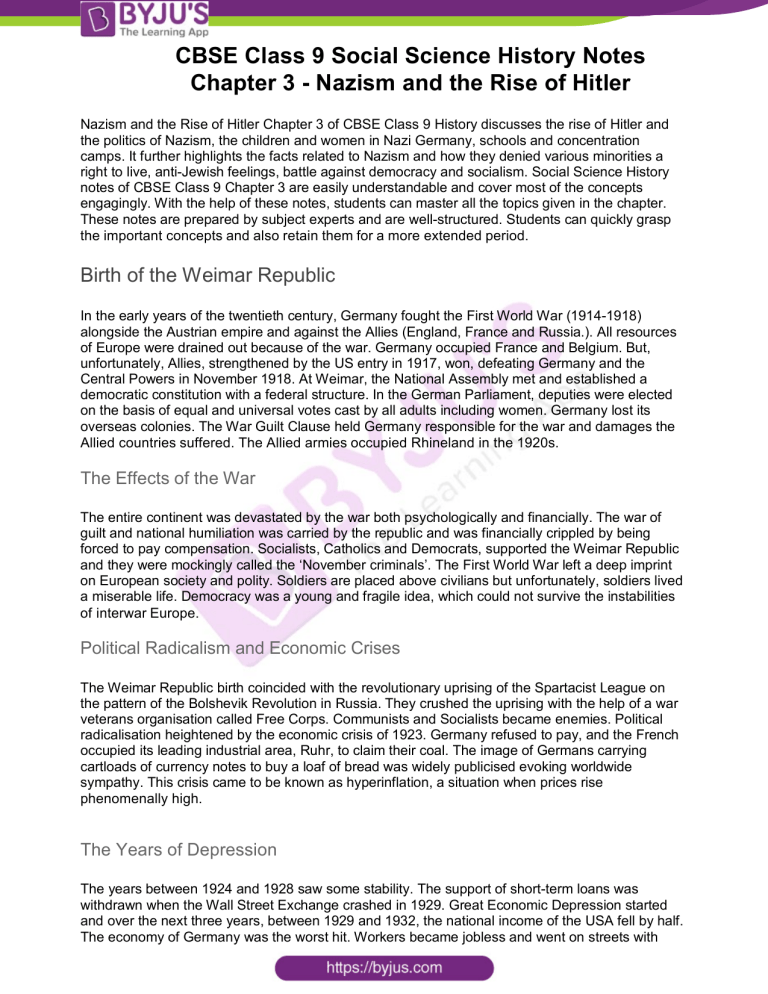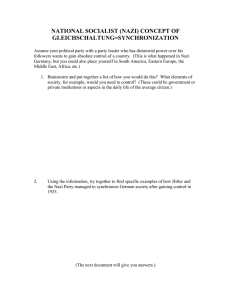
CBSE Class 9 Social Science History Notes Chapter 3 - Nazism and the Rise of Hitler Nazism and the Rise of Hitler Chapter 3 of CBSE Class 9 History discusses the rise of Hitler and the politics of Nazism, the children and women in Nazi Germany, schools and concentration camps. It further highlights the facts related to Nazism and how they denied various minorities a right to live, anti-Jewish feelings, battle against democracy and socialism. Social Science History notes of CBSE Class 9 Chapter 3 are easily understandable and cover most of the concepts engagingly. With the help of these notes, students can master all the topics given in the chapter. These notes are prepared by subject experts and are well-structured. Students can quickly grasp the important concepts and also retain them for a more extended period. Birth of the Weimar Republic In the early years of the twentieth century, Germany fought the First World War (1914-1918) alongside the Austrian empire and against the Allies (England, France and Russia.). All resources of Europe were drained out because of the war. Germany occupied France and Belgium. But, unfortunately, Allies, strengthened by the US entry in 1917, won, defeating Germany and the Central Powers in November 1918. At Weimar, the National Assembly met and established a democratic constitution with a federal structure. In the German Parliament, deputies were elected on the basis of equal and universal votes cast by all adults including women. Germany lost its overseas colonies. The War Guilt Clause held Germany responsible for the war and damages the Allied countries suffered. The Allied armies occupied Rhineland in the 1920s. The Effects of the War The entire continent was devastated by the war both psychologically and financially. The war of guilt and national humiliation was carried by the republic and was financially crippled by being forced to pay compensation. Socialists, Catholics and Democrats, supported the Weimar Republic and they were mockingly called the ‘November criminals’. The First World War left a deep imprint on European society and polity. Soldiers are placed above civilians but unfortunately, soldiers lived a miserable life. Democracy was a young and fragile idea, which could not survive the instabilities of interwar Europe. Political Radicalism and Economic Crises The Weimar Republic birth coincided with the revolutionary uprising of the Spartacist League on the pattern of the Bolshevik Revolution in Russia. They crushed the uprising with the help of a war veterans organisation called Free Corps. Communists and Socialists became enemies. Political radicalisation heightened by the economic crisis of 1923. Germany refused to pay, and the French occupied its leading industrial area, Ruhr, to claim their coal. The image of Germans carrying cartloads of currency notes to buy a loaf of bread was widely publicised evoking worldwide sympathy. This crisis came to be known as hyperinflation, a situation when prices rise phenomenally high. The Years of Depression The years between 1924 and 1928 saw some stability. The support of short-term loans was withdrawn when the Wall Street Exchange crashed in 1929. Great Economic Depression started and over the next three years, between 1929 and 1932, the national income of the USA fell by half. The economy of Germany was the worst hit. Workers became jobless and went on streets with CBSE Class 9 Social Science History Notes Chapter 3 - Nazism and the Rise of Hitler placards saying, ‘Willing to do any work’. Youth indulged themselves in criminal activities. The middle class and small businessmen were filled with the fear of proletarianisation, anxiety of being reduced to the ranks of the working class or unemployment. Politically also the Weimar Republic was fragile. The Weimar constitution due to some inherent defects made it unstable and vulnerable to dictatorship. One inherent defect was proportional representation. Another defect was Article 48, which gave the President the powers to impose emergency, suspend civil rights and rule by decree. Hitler’s Rise to Power Hilter rose to power. He was born in 1889 in Austria and spent his youth in poverty. In the First World War, he enrolled for the army, acted as a messenger in the front, became a corporal, and earned medals for bravery. Hitler joined a small group called the German Workers’ Party in 1919. He took over the organisation and renamed it the National Socialist German Workers’ Party, which later came to be known as the Nazi Party. In 1923, he planned to seize control of Bavaria, march to Berlin and capture power. During the Great Depression, Nazism became a mass movement. After 1929, banks collapsed, businesses shut down, workers lost their jobs and the middle classes were threatened with destitution. In such a situation, Nazi propaganda stirred hopes of a better future. Hitler was a powerful speaker and his words moved people. In his speech, he promised to build a strong nation, undo the injustice of the Versailles Treaty and restore the dignity of the German people. He also promised employment for those looking for work and a secure future for the youth. He promised to weed out all foreign influences and resist all foreign ‘conspiracies’ against Germany. Hitler started following a new style of politics and his followers held big rallies and public meetings to demonstrate support. According to the Nazi propaganda, Hitler was called a messiah, a saviour, as someone who had arrived to deliver people from their distress. The Destruction of Democracy President Hindenburg offered the Chancellorship, on 30 January 1933, the highest position in the cabinet of ministers, to Hitler. The Fire Decree of 28 February 1933 suspended civic rights like freedom of speech, press and assembly that had been guaranteed by the Weimar constitution. On 3 March 1933, the famous Enabling Act was passed which established dictatorship in Germany. The state took control over the economy, media, army and judiciary. Apart from the already existing regular police in green uniform and the SA or the Storm Troopers, these included the Gestapo (secret state police), the SS (the protection squads), criminal police and the Security Service (SD). Reconstruction Economic recovery was assigned to the economist Hjalmar Schacht by Hitler who aimed at full production and full employment through a state-funded work-creation programme. This project produced the famous German superhighways and the people’s car, the Volkswagen. Hitler ruled out the League of Nations in 1933, reoccupied the Rhineland in 1936, and integrated Austria and Germany in 1938 under the slogan, One people, One empire, and One leader. Schacht advised Hitler against investing hugely in rearmament as the state still ran on deficit financing. The Nazi Worldview Nazis are linked to a system of belief and a set of practices. According to their ideology, there was no equality between people, but only a racial hierarchy. Racism of Hitler borrowed from thinkers CBSE Class 9 Social Science History Notes Chapter 3 - Nazism and the Rise of Hitler like Charles Darwin and Herbert Spencer. The argument of Nazi was simple: the strongest race would survive and the weak ones would perish. The Aryan race was the finest who retained its purity, became stronger and dominated the world. The other aspect of Hitler’s ideology related to the geopolitical concept of Lebensraum, or living space. Hitler intended to extend German boundaries by moving eastwards, to concentrate all Germans geographically in one place. Establishment of the Racial State Nazis came into power and quickly began to implement their dream of creating an exclusive racial community of pure Germans. They wanted a society of ‘pure and healthy Nordic Aryans’. Under the Euthanasia Programme, Helmuth’s father had condemned to death many Germans who were considered mentally or physically unfit. Germany occupied Poland and parts of Russia, captured civilians and forced them to work as slave labour. Jews remained the worst sufferers in Nazi Germany. Hitler hated Jews based on pseudoscientific theories of race. From 1933 to 1938 the Nazis terrorised, pauperised and segregated the Jews, compelling them to leave the country. The Racial Utopia Genocide and war became two sides of the same coin. Poland was divided and much of northwestern Poland was annexed to Germany. People of Poland were forced to leave their homes and properties. Members of the Polish intelligentsia were murdered in large numbers, polish children who looked like Aryans were forcibly snatched from their mothers and examined by ‘race experts’. Youth in Nazi Germany Hitler was interested in the youth of the country. Schools were cleansed and purified. Germans and Jews were not allowed to sit or play together. In the 1940s Jews were taken to the gas chambers. Introduction of racial science to justify Nazi ideas of race. Children were taught to be loyal and submissive, hate Jews, and worship Hitler. Youth organisations were responsible for educating German youth in ‘the spirit of National Socialism’. At the age of 14, boys had to join the Nazi youth organisation where they were taught to worship war, glorify aggression and violence, condemn democracy, and hate Jews, communists, Gypsies and all those categorised as ‘undesirable’. Later, they joined the Labour Service, at the age of 18 and served in the armed forces and enter one of the Nazi organisations. In 1922, the Youth League of the Nazis was founded. The Nazi Cult of Motherhood In Nazi Germany, children were told women were different from men. Boys were taught to be aggressive, masculine and steel hearted and girls were told to become good mothers and rear pure-blooded Aryan children. Girls had to maintain purity of the race, distance from Jews, look after their home and teach their children Nazi values. But all mothers were not treated equally. Honours Crosses were awarded to those who encouraged women to produce more children. Bronze cross for four children, silver for six and gold for eight or more. Women who maintained contact with Jews, Poles and Russians were paraded through the town with shaved heads, blackened faces and placards hanging around their necks announcing ‘I have sullied the honour of the nation’. CBSE Class 9 Social Science History Notes Chapter 3 - Nazism and the Rise of Hitler The Art of Propaganda Nazis termed mass killings as special treatment, final solution (for the Jews), euthanasia (for the disabled), selection and disinfections. ‘Evacuation’ meant deporting people to gas chambers. Gas chambers were labelled as ‘‘disinfection-areas’, and looked like bathrooms equipped with fake showerheads. Nazi ideas were spread through visual images, films, radio, posters, catchy slogans and leaflets. Orthodox Jews were stereotyped and marked and were referred to as vermin, rats and pests. The Nazis made equal efforts to appeal to all the different sections of the population. They sought to win their support by suggesting that Nazis alone could solve all their problems. Ordinary People and the Crimes Against Humanity People started seeing the world through Nazi eyes and spoke their Nazi language. They felt hatred and anger against Jews and genuinely believed Nazism would bring prosperity and improve general well-being. Pastor Niemoeller protested an uncanny silence, amongst ordinary Germans against brutal and organised crimes committed in the Nazi empire. Charlotte Beradt’s book called the Third Reich of Dreams describes how Jews themselves began believing in the Nazi stereotypes about them. Knowledge about the Holocaust The war ended and Germany was defeated. While Germans were preoccupied with their own plight, the Jews wanted the world to remember the atrocities and sufferings they had endured during the Nazi killing operations – also called the Holocaust. When they lost the war, the Nazi leadership distributed petrol to its functionaries to destroy all incriminating evidence available in offices.







